Frog and Toad Behavior and Life History -
Movement, Camouflage, and Clustering


|
|||||
| Frog and Toad Movement | |||||
While frogs often use the strength of their muscular hind legs to hop long distances, toads generally move by crawling and using short hops. Take a look at the feeding videos above to see frogs and toads lunging and leaping after food. |
|||||
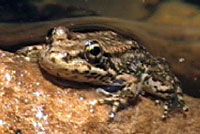 |
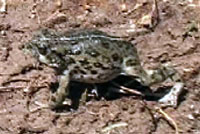 |
 |
|||
| This video shows some Southern Mountain Yellow-legged Frogs in a quiet mountain creek hopping, swimming, and creeping up and lunging after food. | This video shows a California Toad moving both by crawling and by hopping. | This video shows several Black Toads moving around at night in shallow water, hunting for food. | |||
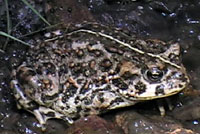 |
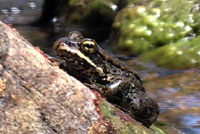 |
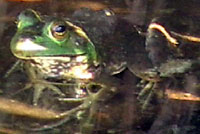 |
|||
| This video shows several Amargosa Toads hopping, swimming, and crawling around at night. | This video shows several Cascades Frogs along a creek, some of them hopping and swimming. | This video shows a few American Bullfrogs including some hopping, diving, and swimming. | |||
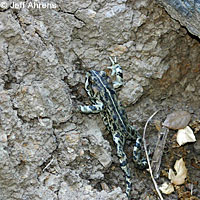 |
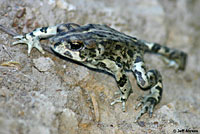 |
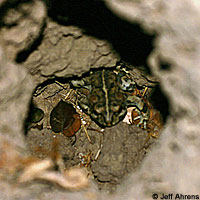 |
|||
| Toads are surprisingly good climbers. This California Toad was photographed climbing the steep walls of a canyon in San Bernardino County to get to a burrow, which you can see in the third picture. © Jeff Ahrens |
|||||
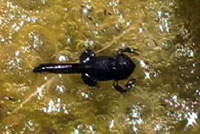 |
|||||
| This video shows tiny Red-spotted Toads that have just transformed from tadpoles, hoping across an algae mat on a pond. |
|||||
| Camouflage and Defense | |||||
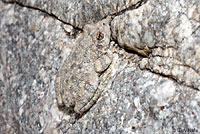 |
 |
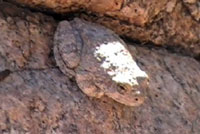 |
|||
| Canyon Treefrogs are colored and patterned to match the rocks along the creeks where they live. They also hunch themselves over, hiding their legs, so they look like little clumps of rock. This camouflage helps them hide from predators. | Canyon Treefrogs, barely visable at a distance on a large boulder. | This video shows a few Canyon Treefrogs on rocks along a creek. |
|||
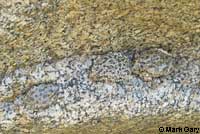 |
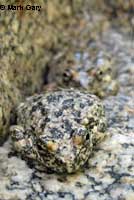 |
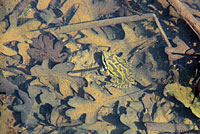 |
|||
| Several adult California Treefrogs (or Chorus Frogs) blend in perfectly with the creek-side granite rocks they sit on. © Mark Gary | Adult Sierran Treefrog. The color and pattern of some treefrogs helps them to blend into their surroundings to avoid detection. | ||||
| Other Defense Strategies | |||||
 |
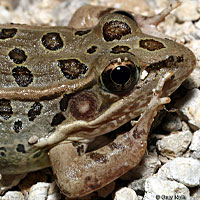 |
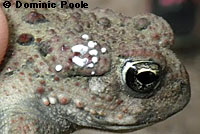 |
|||
| This frightened Rio Grande Leopard Frog pulled its front hands in front of its eyes, maybe to protect them from attack. | This California Toad shows white milky secretions from the parotoid glands which contain noxious chemicals that help to deter some predators. © Dominic Poole |
||||
| Flash Color on legs used to distract predators. | |||||
| When a frog fears an attack from a predator, it jumps away, stretching the legs out and exposing the bright flash color. The predator automatically focuses on the bright color when it pursues the frog, but the color suddenly disappears when the frog lands and folds up its legs. This can confuse the predator long enough to allow the frog to escape. | |||||
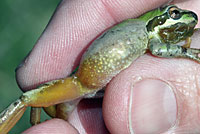 |
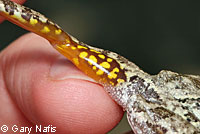 |
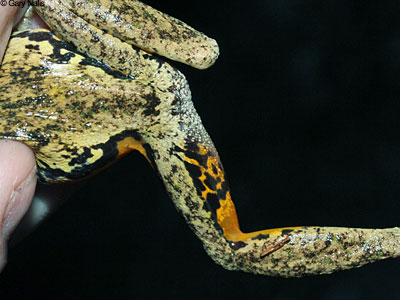 |
|||
| Adult male Sierran Treefrog showing yellow "flash color" markings on the inner thighs. | Another example of flash color on the thighs of a Gray Treefrog. | Flash mark on inside of rear leg of an Australian frog, an Emerald-spotted Tree Frog. | |||
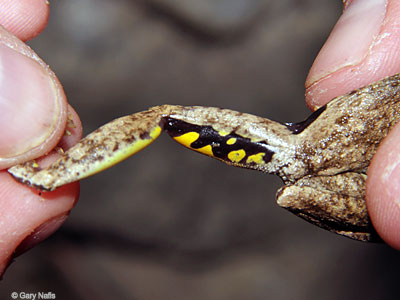 |
|||||
| Flash markings on a Northern Laughing Tree Frog from Australia | |||||
| Clustering and other social Interactions | |||||
Sometimes frogs congregate into groups. One study tested whether some juvenile toads gathered together for protection or to keep from getting too dry, or desiccating, and concluded that the clustering reduced desiccation. |
|||||
 |
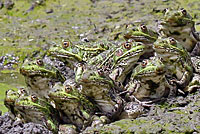 |
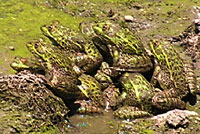 |
|||
| Chiricahua Leopard Frogs These frogs gradually gathered into small and large groups at the edge of a pond, even climbing up onto the backs of other frogs. |
Chiricahua Leopard Frogs This video shows frogs diving into the water, and later a number of frog clusters. |
||||
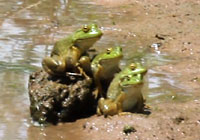 |
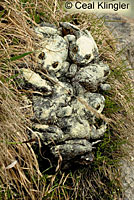 |
||||
| In this short video, American Bullfrogs sitting around a crowded pond group together and interact with each other, making what appear to be territorial sounds. | A congregation of Sierra Nevada Yellow-legged Frogs. These frogs were discovered on the south-facing slope of a barely ice-free alpine lake (11,000 ft.). They are covered with pollen, wind-blown from lower altitudes, which coated the area. © Ceal Klingler |
||||
Return to the Top
© 2000 -
